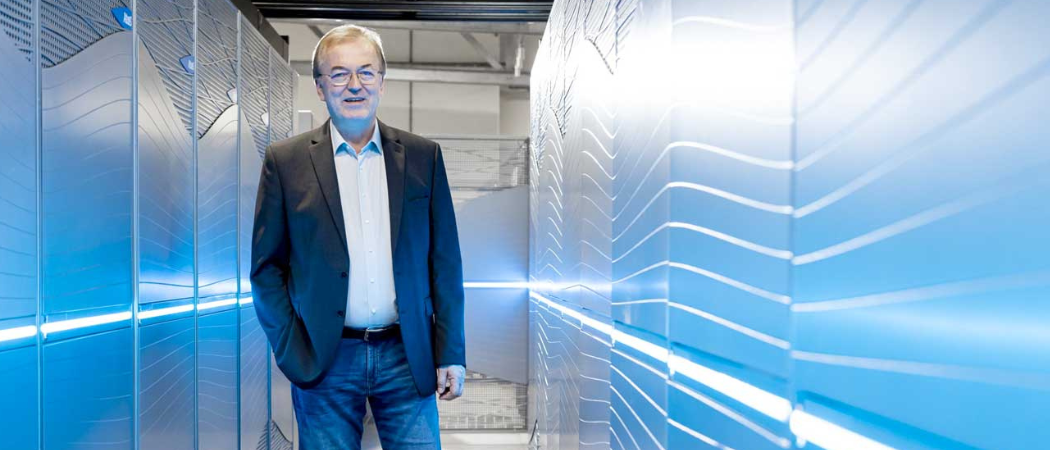Europe will see the switch-on of Jupiter, one of the most powerful supercomputers in the world, later this year

Thomas Lippert, head of the Jülich Supercomputing Centre (JSC). Photo: Sascha Kreklau / Forschungszentrum Jülich
Europe’s first exascale supercomputer could be up and running with as many as 100 projects by the second half of this year, allowing researchers to develop increasingly complex climate simulations and artificial intelligence systems.
Jupiter will be the first European system capable of one exaflop, or one billion billion calculations per second, making it one of the world’s most powerful machines.
“We believe we are scientifically on the same level as the US and China,” said Thomas Lippert, head of Jülich Supercomputing Centre in Germany, where Jupiter is to be installed.
The world’s first exascale supercomputer, Frontier, began operating in Tennessee in May 2022. China is believed to have exascale machines, but these do not feature on official lists because the country does not run the standard benchmark tests.
The team behind Jupiter is focused on the scientific potential it will generates, rather than international comparisons. “We have never seen the whole thing as a competition between the US and Europe,” Lippert said.
The €273 million project is co-funded by the EU’s High Performance Computing joint undertaking (EuroHPC JU) and the German government.
Processing time on Jupiter will be available to industry, academia, and public bodies, for applications including training large language AI models, creating digital twins of the human heart or brain, and climate simulations – increasingly complex models requiring an exponential increase in computing capabilities.
With a cubic simulation, for example, “increasing each spatial and the time dimension of a physical system only by a factor of two already requires a factor of 16 more compute power,” Lippert explains.
On Wednesday, the Commission is due to unveil plans to give AI start-ups easier access to EU supercomputers, including Jupiter.
While it is primarily designed for scientific uses, Lippert says Jupiter can act as an “intermediate machine” for industry, filling a gap since it would take an individual company three or four years to install their own machine, and at great cost.
In the future, he believes companies should have their own capabilities. “It’s not that some public machines will solve all the world’s problems,” he said. “Jupiter is just the starting point.”
Compute-intensive problems
Jupiter, being built by Eviden and Partec, is composed of a graphics processing units-based booster module for particularly compute-intensive problems, and a cluster module which will be especially useful for complex, data-intensive tasks.
The booster module will be powered by GPUs from US firm Nvidia, while Jupiter’s microprocessors are made to the design of a European company, SiPearl, a first for EuroHPC.
The EU-backed start-up was not only chosen for reasons of sovereignty. The SiPearl chip offers a level of efficiency for complex, data-intensive applications which is “unique in the world”, Lippert said, and perfect for Jupiter’s modular approach. “It’s exactly the module we need to do the data curation, and many of the preparatory steps for the big booster.”
The modular design is intended to enable the machine to change with the times, as it can be improved in stages. “After seven or eight years, the modules will be transported back to the factory. They can be used as a container, but the inside will be removed and refurbished for the next technology,” Lippert said.
Similarly, modules of the supercomputer will be stored in containers which can also be replaced. “We are pioneering the way to operate big systems,” he said. “If you build a machine with today's cooling and energy technology, if you have a building for that machine, it might not be the right building for your next machine.”
Logistics have however proved a challenge, and war damage to Ukraine’s electricity supply system means that currently there is a shortage of transformers. “Transformers have to go to Ukraine to rebuild their electricity – that’s where they’re more important,” Lippert said.
The largest supercomputers require the same amount of electricity as a town of 100,000 people. Jupiter’s energy costs are estimated at around €20 million per year, and the supply will need to be incredibly stable and capable of coping with extreme peaks. “You cannot afford to have a power cut. Even for a millisecond would be devastating,” Lippert noted.
The latest developments in supercomputer technology have only been possible because of improved energy efficiency, and these will need to continue as the demand for computing power grows.
“A decade ago, people were saying if an exascale supercomputer were to be built with the technology of the day, the annual energy bill would be around €120 million,” said Steve Conway, senior analyst at Intersect360 Research in the US where he tracks the high-performance computing (HPC) market. “I don’t think any government would have funded an exascale computer with that technology.”
Global leader
Jupiter illustrates of the progress Europe has made in supercomputing since deciding to pool its resources. In the latest Top500 ranking of the world’s fastest machines, Europe holds 143 spots, and three out of the top 10.
“A decade ago, Europe was out of the running,” said Conway. “Now, Europe is one of the global leaders.”
In 2010, Conway was working at the market analyst International Data Corporation, which was brought in to work with the European Commission on recommendations for a European HPC strategy.
Central to the evolution since then, he says, has been the EuroHPC initiative and especially the changes to funding rules allowing the largest supercomputers to be funded typically 50% by the Commission and the rest by the host country or a consortium of countries. “Without that change, none of this could have happened,” Conway said.
In Conway’s view, it is essential for Europe to have independent supercomputer technology. “[It] underpins a lot of manufacturing, weather forecasting, oil exploration, all kinds of things which are economically very important,” he said.
The next challenge for Europe is to foster another major company capable of building supercomputers.



 Follow where the public and private R&I money is going and which collaborative opportunities you can pursue.
Follow where the public and private R&I money is going and which collaborative opportunities you can pursue.